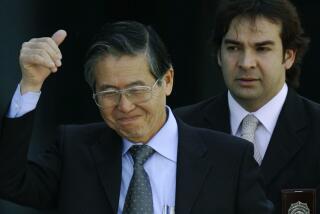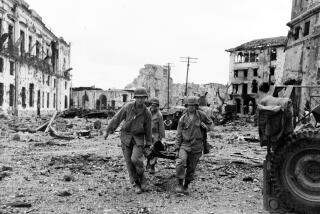Book Reveals Hirohito the Militarist
TOKYO — Dec. 8, 1941, was a busy day for Emperor Hirohito.
After receiving reports of the successful Japanese surprise attacks on Pearl Harbor and other strategic sites in the Pacific--a battle plan he had known about in intimate detail for a month--he spent the day in meetings with his prime minister, privy council and senior military leaders.
“Throughout the day, the emperor wore his naval uniform and seemed to be in a splendid mood,” recorded the diary of Hirohito’s top naval aide, Eiichiro Jo.
A biting biography to be published later this month demolishes the stereotype of Japan’s wartime emperor as a mousy and passive figurehead who was merely the puppet of the militarist clique that drove the nation to war.
“Hirohito and the Making of Modern Japan,” a potentially politically charged tome by historian Herbert P. Bix, is already drawing plaudits from scholars on both sides of the Pacific. It portrays the late emperor as smarter, shrewder, better informed and more energetic than people thought.
Unapologetic to the last, Hirohito was an autocrat whose ultimate loyalty was not to his people but to his ancestors, the book asserts. He hid behind his passive image but was in fact at the very center of the Japanese political system--not only before but also after World War II.
The book documents how Hirohito and his aides collaborated with U.S. occupation authorities to shield the emperor from any responsibility for the aggression committed in his name. Bix argues that this joint whitewash--which protected the political interests of each nation--fundamentally distorted the development of Japanese democracy.
The Japanese-based Bix, whose book is scheduled to be released by HarperCollins in the U.S. on Aug. 27, draws on letters and diaries of Imperial Court and government officials and other documents, many of which have only begun to trickle out in the 11 years since Hirohito’s death.
Scholars predicted that the book will spur demands for the governments of Japan and America to throw open still-secret records from the war. A resolution demanding that the United States declassify information about Japanese war crimes is pending in the U.S. Senate.
The book may also give fresh ammunition to the U.S. activists who are waging a legal and political campaign to force Japan to take more meaningful responsibility for its wartime transgressions.
“It’s utterly sensational,” said Chalmers Johnson, president of the Japan Policy Research Institute in Cardiff, Calif., who predicted that the book will be “of great political significance.”
“Bix reveals new information on the degree to which the U.S. government systematically deceived its own people and the rest of the world about Hirohito’s involvement,” Johnson said. “Hirohito was placed back on the throne and told to keep his mouth shut in order to make Japan what it is today: a secure American satellite.”
Evidence of Efforts to Fix Trial Testimony
Among other bombshells, the book presents evidence that senior aides to Gen. Douglas MacArthur and Japanese court officials schemed to fix testimony at the Tokyo War Crimes Trials so as not to implicate Hirohito.
Historian John W. Dower, whose book on the U.S. occupation, “Embracing Defeat,” won a Pulitzer Prize this year, called the Bix biography “a very important book” that incorporates the best recent Japanese scholarship and materials to which no previous Western writers have had access.
“The emperor’s new clothes are that this is a very complex individual who plays an extraordinarily important political role,” Dower, a professor at the Massachusetts Institute of Technology, said in a telephone interview. “It’s new to most Westerners, because there was a big cover-up after World War II, and that continued in academia and the media.”
Historian Michael Schaller said he hopes that the Bix book will increase pressure for the prompt release of relevant documents by both countries.
“What the book shows is not that Hirohito was the most evil man in the world, but that he was a knowing participant in a violent expansionist regime, the full record of which is still obscured by claims of national security by Japan and the U.S.,” Schaller said.
The U.S. decision to spare Hirohito from prosecution was intended first to ensure an orderly and disciplined Japanese surrender and cooperation with the occupation, and then, as the Cold War deepened, to facilitate the speedy rebuilding of Japan as a constitutional monarchy that would provide an anti-Communist bulwark in Asia.
Prime Ministers Kept the Emperor Informed
The book shows how Hirohito supported an unsuccessful attempt to get him restored as head of state. He developed a “warm relationship” with postwar Liberal Democratic Party Prime Ministers Eisaku Sato, who went out of his way to report to the emperor on state affairs, and then Kakuei Tanaka. Hirohito “is the spiritual godfather of uninterrupted, one-party LDP rule,” Bix said in an interview.
From the early 1960s, Hirohito received secret top-level military briefings, in violation of the constitution, until the practice was revealed in a well-reported 1973 scandal. The formal briefings by the head of Japan’s Self-Defense Forces were halted.
Meanwhile, what Americans saw was Hirohito’s 1975 state visit to the U.S., which included a trip to Disneyland, where he was photographed with Mickey Mouse. Writes Bix: “Photographs of the elderly emperor delighted many Americans, and seemed to confirm the false stereotype of him as a monarch who had always been peace-minded but helpless.”
In fact, Hirohito was trained from birth to defend his throne in an era when monarchs the world over were losing theirs. His military education began at age 8, and by 1940, according to Bix, he had become “a real war leader.”
“Eventually Hirohito became the prime symbol of his people’s repression of their wartime past,” Bix writes. “For as long as they did not pursue his central role in the war, they did not have to question their own.”
The allegation that Japan has shirked its responsibility for the war remains of more than academic interest. Lawsuits by alleged slave laborers for Japanese corporations and by former Allied prisoners of war challenge the shared position of the U.S. and Japanese governments that all war compensation issues were settled under the 1951 San Francisco peace treaty.
One of those former POWs, retired historian Lester I. Tenney, 80, was in Japan last week lecturing on his experiences and trying to chip away at what he sees as a Japanese culture of denial.
“There’s no question that the Japanese people feel that since Hirohito was pronounced innocent, then they are innocent,” Tenney said. “I think that may be the reason why there has never been a full, open and honest apology.”
Then-Prime Minister Tomiichi Murayama issued a formal apology in 1995, and Japan has paid more than $27 billion in compensation to about 27 other governments. Yet, unlike Germany, Japan has never been able to apologize or accept responsibility in such a way that would convince and appease victims and critics. Bix, as well as other scholars, argues that what Japanese liberals call “the emperor problem” is the root cause.
Hirohito “lacked all consciousness of personal responsibility for what Japan had done abroad and never once admitted guilt for the war of aggression,” Bix writes. The book skewers Hirohito’s hypocrisy, noting that the emperor was instrumental in delaying the Japanese surrender but after the war said of the U.S. atomic bombings, “It could not be helped.”
“Up until now, we’ve all blamed the military die-hards, but Hirohito was one of the military die-hards,” Bix said.
Many sections of the book have deep relevance to Japanese politics today. The failure to repudiate Hirohito explains why Prime Minister Yoshiro Mori triggered a storm of domestic protest, and raised hackles across Asia, when he recently called Japan “a divine nation with the emperor at its center.”
It also explains why Japanese opposition leaders were furious earlier this year when the LDP proposed renaming the Greenery Day national holiday--Hirohito’s April 29 birthday--as “Showa Day” in honor of the wartime emperor. The plan has since been dropped.
Bix also details the sometimes-lethal campaign of intimidation waged by the Japanese right that successfully imposed a “chrysanthemum taboo” against any criticism of the emperor. The result was a self-censorship that mocked the newly guaranteed constitutional freedoms of expression and “deformed Japanese democracy,” Bix said.
The biography is revealing in pointing out the parts of the historical record that remain blank.
Hirohito is believed to have kept a diary from age 11, but it has never been made public. A fax to the Imperial Household Agency asking whether the diary exists and when historians might be allowed to see it was answered with a polite “no comment.”
Bix details a host of other documents, in Japan and the U.S., that cannot be viewed, including some of the late emperor’s correspondence, the Hirohito file in the U.S. National Archives and whatever records might exist of the 11 meetings between Hirohito and MacArthur.
Bix, a scholar in the renowned history department of Hitotsubashi University, has managed to flush out a trove of documents. He credits his Japanese colleagues for sharing with him their insights as well as unearthing documents that were spared the bonfires ordered by the Japanese Cabinet upon surrender, papers that were sometimes shoved into barrels and buried in private gardens for decades.
Bix said he hasn’t secured a Japanese publisher, but historian Osamu Watanabe said the book will probably be translated into Japanese because of this country’s longtime preoccupation with how it is viewed by the West. Although its portrait of the emperor is distinctly unflattering, Watanabe said, the 800-page book is so meticulously researched that the Japanese right wing will find it difficult to discredit.
“Mr. Bix has done more research than many Japanese scholars,” Watanabe said. “I believe it will be quite difficult for the right to find flaws with which to attack.”
More to Read
Sign up for our Book Club newsletter
Get the latest news, events and more from the Los Angeles Times Book Club, and help us get L.A. reading and talking.
You may occasionally receive promotional content from the Los Angeles Times.









